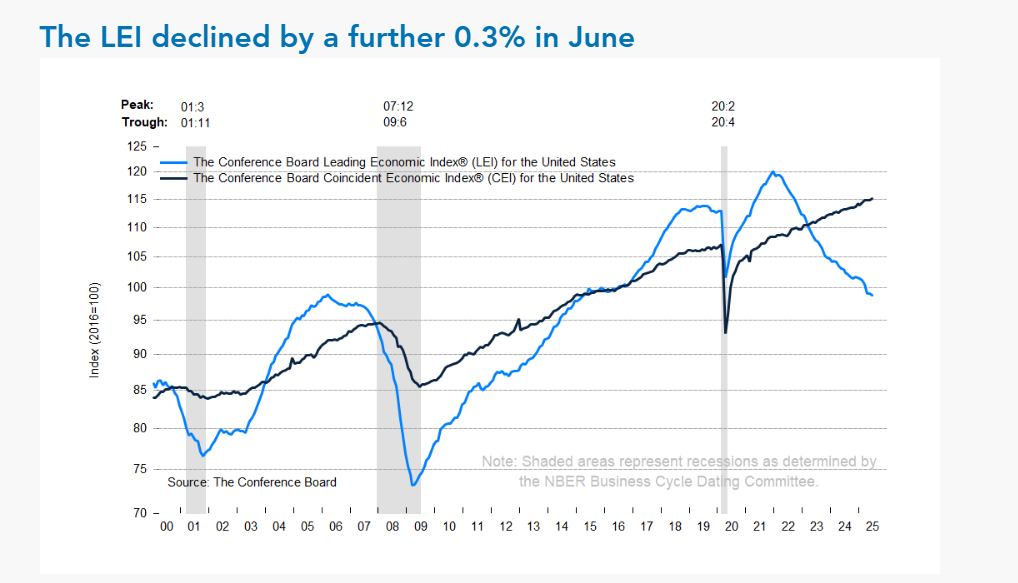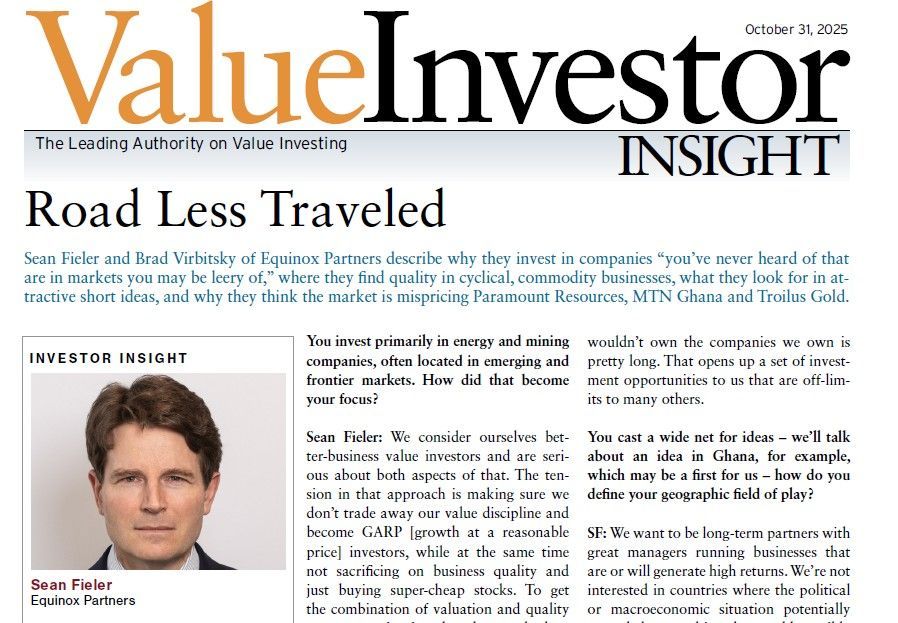Equinox Partners, L.P. - Q1 2001 Letter
Dear Partners and Friends,
Performance
In the past two quarters, Equinox’s outsized short position in technology stocks was quite profitable, as were our shorts in troubled and fraudulent businesses. Other short positions, in many cases serving as refuge for frightened growth stock investors, have only recently become profitable.
On the long side of Equinox’s portfolio, one of our contrarian stock themes has performed well. From their lows last spring, our domestic tobacco stocks have almost tripled. Though the cigarette litigation environment is perceived to have improved (despite industry’s actual loss of the largest product liability suit in history in a local Florida court), the main source of strength for these stocks, beyond their record low valuations, has been their defensive nature. By serving as a refuge for nervous equity investors, even the tobacco businesses’ valuations are still a function of the “New Economic Paradigm”—only this time in reverse.
Our other “contrarian” longs, comprising the bulk of our portfolio, have not made money for Equinox in recent quarters. For example, our energy shares have yet to meaningfully respond to the startling increase in the price of scarce North American natural gas. And despite the U.S. stock market and economic setbacks the dollar has retained its phenomenal luster, causing our forsaken precious metals investments to retain most of that distinction. In addition to our deeply undervalued Asian companies, other potential beneficiaries of a dollar decline are our small but growing long positions in undervalued European businesses. As European markets follow the U.S. lower, we are just beginning to find Equinox-like bargains on that continent.
The initial revalution of worldwide equities, both up and down, has proceeded with a surprisingly measured pace. The global bear market in technology and telecom stocks, while severe, has been orderly so far. While this has proved frustrating to our efforts to leverage our short portfolio with puts, it does provide us with multiple opportunities to change the mix of our shorts and to revisit those sectors which “bounce.” The continuing infatuation with technology companies is also providing us with multiple opportunities to own deeply discounted long positions that have been out of favor during the earlier manic phase.
“All the Kings Horses and All the Kings Men…” The Mania at the First Anniversary of Its Peak
The graph below provides a long-term snapshot of the trajectory of the incredible stock market mania that dominated world markets during the 1990’s. This is because the level of margin borrowing is both a cause and effect of stock market speculation.
Customer Margin Debt as of February 2001
Because of our unassailable confidence in our bottom-up value investment strategy, Equinox’s investment fate was to be the mirror image of this mania. Well aware of the asymmetry of short selling, but thinking that the parabolic rise of equity valuations could not continue, (Greenspan’s “irrational exuberance” speech was in December, 1996) we consciously bet against this trend. But the mania intensified still further, peaking only one year ago.
Although American stocks remain volatile (e.g. in January of this year Cisco Systems’ stock market capitalization swung $65 billion in one day-- three times the company’s annual sales!), it seems apparent that the extraordinary surge pictured above has finally passed its crest. We believe the demise of the 1990’s Humpty Dumpty stock market is not only irreversible but has much further to go.
Our assertion that the reversal of the 1990’s manic valuation anomalies is far from over rests on two fundamental premises:
1. Valuation The valuation extremes of the preceding bull market require a considerable further decline to reestablish even normal, let alone bargain, valuations. Consider the P/E for the American NASDAQ index. Despite its significant decline, the most recent estimate we have seen suggests the Over-the-Counter market is still selling for 150 times declining net income. This astronomically high multiple is only a “bargain” in comparison to its peak multiple a year ago—400 times! Broader U.S. indices still sell for richer valuations than those in the summer of 1929. To state the obvious, the reason that stocks are still significantly overpriced at these lower levels is that they were so incredibly overpriced at the peak.
This is not to say that global stock markets can not rally. Indeed, bear market rallies are notoriously sharp. The restructuring of Equinox’s short portfolio, as described below, has substantially reduce the risk from our short side.
2. Economic Our second reason for believing the domestic stock market correction has further to run, involves future economic performance. We are referring to the vulnerability of the global economy as a result of the previous extremes of the boom times (e.g. double-digit nominal GDP growth in the U.S.). Those extremes developed as a function of the self-reinforcing nature of economic behavior that George Soros calls “reflexivity.” The unprecedented 1990’s boom was especially reflexive. From momentum investing to the underinvestment in energy that resulted from the massive overinvestment in technology, examples of this phenomenon abound. And as the “New Economic Paradigm” fed on itself on the way up, it probably will do likewise on the way down, thereby exaggerating the ultimate economic decline.
U.S. Savings Rate as Percentage of Disposable Income Thru February 2001
Consider the dramatic decline in the proportion of their income that Americans save as pictured above. To our knowledge, there has never been a similar example of an increase in the propensity to borrow and spend. During the 1990’s credit card debt per household almost tripled. And Americans’ practice of borrowing and spending the equity in their homes has lowered the homeowners’ “equity cushion” to the lowest ever, despite monthly mortgage repayment and rising house prices. Our local Citibank branch has just started advertising, “There’s got to be at least $25,000 hidden in your house. We can help you find it.” As Fortune magazine (April 2, 2001) notes in a recent article on US consumer confidence:
“Right now, the refinancings and the cash-outs are buoying the economy because they give consumers more cash to burn. As Zandi(an economist) notes, ‘the refinancing wave could very well turn out to be instrumental in forestalling a more severe economic downturn.’ But he and other economists also see a darker side. By increasing their mortgage debt, writes Zandi, ‘cash-out re-fiers are weakening their balance sheets, making them more vulnerable to future financial problems.”
We do not think the dramatic drop in the savings rate is simply coincidental with the greatest stock market expansion of all time. If indeed the equity wealth effect caused the spending boom in the U.S., what does the decline in stock prices imply for future consumer spending? If reflexivity functions in reverse, consumer spending could drop precipitously (though consumer confidence has declined, the savings rate was still declining as recently as February of this year). In the future increasing unemployment, caused by companies trying to reestablish their past profitability, might cause heavily leveraged American consumers to spend less and fail to meet some of their debt service payments. Many stocks that should be adversely affected by these trends have yet to decline from their recent high valuations. Equinox has added such companies to our short exposure.
The “Seesaw Stock Market”: Equinox Broadens its Short Portfolio
Dow Jones down, NASDAQ up. NASDAQ down, Dow Jones up. In 1999 and early 2000, the old-fashioned Dow Jones Industrial Index declined while tech stocks soared. However, from the peak in tech stock speculation a year ago, America’s “seesaw stock market” (sector rotational investing) gave its tech-stock passengers a very unpleasant ride. It also provided Equinox with three successive quarters of escalating profits derived from our very outsized shorts in these companies. But the locus of the U.S. bear market was, until March 2001, essentially confined to the heretofore-sacrosanct tech/telecom sector. Few realize that the S&P 500 index, ex-technology stocks, hit an all time high at the end of last year.
The “seesaw” U.S. stock market has been a function of investors’ unshakeable confidence that the stock market provides superior returns in the long run. Never mind that this shibboleth is not necessarily accurate (It took the Dow Jones Industrials a quarter century to regain its levels of the late 1920’s, and in the last decade, Japanese stocks have lost two-thirds of their value). As “buying the dips” of “New Economy” shares has become a formula for compounding losses, Americans switched to buying “Old Economy” shares last year. Even during a week in mid-March of this year New York Stock Exchange New Highs prevailed over New Lows by an impressive ratio of 6:1.
Most investors are not aware of the speculative valuations of many non-technology shares. Though not as egregious as the tech mania, many popular large companies are, and have been for some time, selling for multiples of sensible valuations in the boom years of the U.S. economy, let alone in the recessionary environs of today. Recall what the massive dollar inflow into index funds during most of the late 1990’s did to the valuations of S & P 500 companies. For years, U.S. investors enjoyed extraordinary returns by purchasing mutual funds that were indexed to the S & P 500 index. This practice waned as the dot-com “investment” performance superceded even the self-reinforcing rich returns of index fund speculation. Nonetheless, trillions of mutual fund dollars remain lodged in this “passive” investment strategy and those that mimic it. We think that the recent initial net redemptions of index mutual funds represents an important straw-in-the-wind in the development of the domestic bear market.
Monthly Net New Cash Flowing into S&P 500 Index Funds
(in billions)
Equinox has made a lot of money shorting technology shares. However, because of expensive non-tech stocks and a declining global economy, Equinox has altered our short portfolio by significantly broadening our exposure to overvalued domestic stocks. Although we are not of the opinion that technology shares are reasonably valued at these much lower prices, we have covered most of these shorts to make room for a broader array of shorts. We have identified other overpriced shares in businesses (financial and retail) and locals (California) that will be impacted by the stock market decline and the slowing of the U.S. economy. The recent appreciation of these shares provides Equinox with a “second bite of the short apple.”
America’s Emerging Energy Shortage
The sexier part of America’s emerging energy shortfall story, electricity, has become highly visible. Bankruptcies and blackouts in California this past winter are front-page news. But the real trouble for the world’s sixth largest economy is likely to strike this summer, traditionally the season of peak electrical demand. In addition, the East Coast may suffer a long, hot summer this year because of a similar shortage (we only avoided blackouts last year because the summer was one of the coolest on record). It is unlikely that the sharp contraction of the investment banking business will remain the only economic problem the Big Apple faces this summer.
While the business of constructing new electrical generating capacity has spawned “New Economy” stock valuations, the companies that will provide the fuel for these new plants, natural gas, remain at the lowest valuations in the industry’s history. Since our last letter, the evolution of investor sentiment towards the energy sector is reflected in Morgan Stanely’s late February “Strategy and Economics” memo:
“As gas and oil prices have remained elevated, the (investor) consensus has taken an aggressively skeptical stance regarding energy stocks—much more so than any other S & P 500 sector. … Expectations for massively reduced second-half energy earnings are all the more notable as the sector is one of only two (with utilities) that is still experiencing more upward than downward (earnings) revisions. … In a market that has fought the concept of reversion to the mean at every turn, the energy sector stands out for how aggressively investors now expect things to revert to the perceived norms (e.g. lower oil and gas prices).”
The low energy prices implied by the record low energy stock valuations seem to incorporate the view that higher prices lead to an economic contraction, which leads back to low energy prices. The circularity of the pessimistic rationale neglects the supply side of the price equation. We believe OPEC’s new found supply resolve recognizes the fact that world oil production is near capacity. But North American natural gas has a unique supply constraint, gas well decline rates in excess of 20% each year. The “accelerating treadmill” metaphor for gas production is apparent in the difficulty most gas producers we follow have in even maintaining output. (This is why we believe that Equinox’s gas producers, who are actually increasing production, are so valuable.) With significant new sources of supply like liquefied natural gas (LNG) years away, we assert that gas prices will remain strong.
The positive economics of energy are visible in the California morass. With reliability of supply such a high priority, Governor Davis is contracting for long-term electricity supply from independent power producers. One of the most aggressive of the new power plant builders, Calpine, plans to increase its generating capacity over the next five years (65,000 Megawatts) so as to require incremental annual gas consumption of 3 trillion cubic feet/year. This equals Canada’s entire current natural gas export to the U.S.! In anticipation of its substantial new power-plant development projects, Calpine must secure long-term natural gas reserves to “lock-in” its profit margin on its long-term electricity supply contracts with the likes of California. The following table illustrates Calpine’s recent purchase of Canadian producer Encal.
Calpine Contracts to Calpine Acquires Encal for its
Sell Electricity to CA (US$) Future Nat Gas Production (US$)
Contracted Price ($/MwH) $66
Operating Cost / MwH - $10
Implied Price of Fuel / MwH =$56
McFs of Nat Gas / MwH 7
Implied Price of Natural Gas =$8 ($56/7) $4 (Implied Cost of Nat Gas)
The deal represents the purchase of future gas production at a cost to Calpine of US$4/mcf. This compares very favorably with Calpine’s electricity sale price that effectively sells the gas, after profitably converting it to electricity, at US$8/mcf. The extraordinary profit that Calpine locks in with this transaction means we have not heard the last of Calpine’s aggressive pursuit of Canadian gas reserves!
This interest in purchasing gas reserves on the stock market by electricity power generators coincides with other energy conglomerates’ need to own reserves as part of a “total energy solution” marketing strategy. In addition, other oil and gas producers recognize that gas can be “found” more cheaply on the stock exchange than in the ground. The “real world” competition for gas reserves that has ensued is in sharp contrast with the pessimism of energy stock investors. Characteristically, Equinox’s position is consistent with the “real world.”
Profit Potential From the Current “What Me Worry” Financial Attitude
Such indicators as Americans’ still positive sentiment towards technology investments, their unwillingness to reduce consumption and the skeptical investor attitude towards our energy problem, imply that our countrymen have been suffering from a sort of denial about the now apparent ephemeral nature of the “New Economic Paradigm.” It is as if investors are sure that Cisco Systems will soon return to $80/share. After years of economic euphoria, stoked by an unending bull market and the conviction that technology will solve any economic problem, the return to reality will be a bitter pill. Mad magazine’s Alfred E. Neuman captured the mood with his, “What, me worry?” However, whether it is the end of the growth stock mania or the shortfall of cheap energy, the logic of supply and demand must finally reassert itself. Our portfolio’s incipient profitability is beginning to reflect the fundamental developments we have discussed for years.
Some believe that because the NASDAQ has lost two-thirds of its value, the short-selling opportunity is over. As discussed above, we fundamentally disagree. That said however, Equinox has chosen to pursue a lower risk shorting strategy that we believe to be equally prospectively profitable. However, Equinox’s continuing contrarian prospects are not limited to shorting overpriced stocks. More specifically, the undervaluation of our long positions, created by the distortions of the late mania, suggest even greater returns than shorting. The stock market reappraisal of most of our contrarian longs is just beginning.
Moreover, from our energy producers to our Asian and European businesses to our precious metals companies, our longs share something more than their astounding cheapness—namely, in each case we believe we have identified “best of breed” managements within their industries. These managers are true “executive marathoners” (one is literally an “ultra” marathon runner) whose focus is unrivaled and whose dedication allows them to not only survive, but thrive in the context of the current strenuous environments of their respective economies and industries. As with these managers, at Equinox we are optimistic about the long term prospects of continuously exercising a focused discipline of sensible investment. We look forward to sharing with you the ongoing rewards of our “micro” discipline of studied valuation/business/management stock picking as the head wind we have faced for so long finally subsides. These rewards should be substantial as the wind shifts to our backs. We believe this time has come.
Sincerely,
William W. Strong
Anthony R. Campbell









